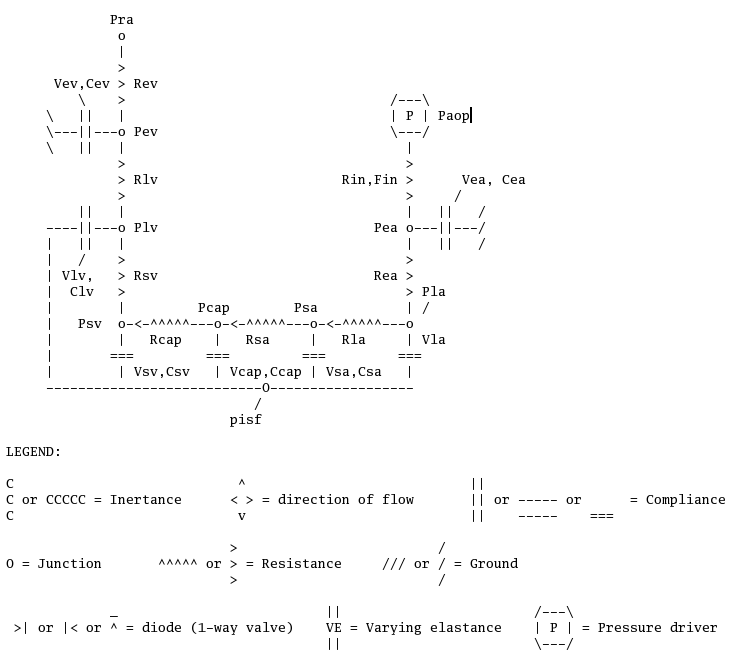A lumped parameter model of the coronary circulation. A resistive-compliant network is used to simulate the following circulatory compartments: epicardial arteries, large coronary arteries, small coronary arteries, coronary capillaries, small coronary veins, large coronary veins, and epicardial veins.
Description
Myocardial mechanics, perfusion and across-capillary mass transport are functionally related. The effects of these interacting phenomena on the performance of the left ventricle (LV) are investigated here. The effect of fluid balance on the diastolic and systolic intramyocardial pressures (IMP) and the interstitial and myocardial volumes as well as the global ventricular mechanics are of particular interest. The LV is approximated by a cylindrical geometry, containing blood vessels imbedded in the interstitial fluid and a fibrous matrix with active and passive elements. The coronary circulation is described by pressure dependent resistance-capacitance analog elements. Fluid and mass transport are calculated assuming an ideal semipermeable capillary wall and the lymphatic drainage depends linearly on the IMP. Changes in lymphatic flow are used to simulate edema formation, and its effects on myocardial mechanics and coronary flow. The empty beating and isovolumic contracting hearts are studied under constant coronary perfusion pressures. The model successfully predicts the corresponding changes of the coronary flow, the IMP, the LV pressure and the ventricular compliance. The simulated effects of a transient contractile dysfunction on the dynamics of fluid transport and coronary flow are in agreement with experimental data.

Equations






















The equations for this model may be viewed by running the JSim model applet and clicking on the Source tab at the bottom left of JSim's Run Time graphical user interface. The equations are written in JSim's Mathematical Modeling Language (MML). See the Introduction to MML and the MML Reference Manual. Additional documentation for MML can be found by using the search option at the Physiome home page.
- Download JSim model MML code (text):
- Download translated SBML version of model (if available):
We welcome comments and feedback for this model. Please use the button below to send comments:
Zinemanas D, Beyar R, Sideman S. Relating mechanics, blood flow and mass transport in the cardiac muscle. Int. J. Heat Mass Transfer. 37(suppl. 1) 191-205, 1994. Ohm GS. Die galvanische Kette mathematisch bearbeitet, 1827
Please cite https://www.imagwiki.nibib.nih.gov/physiome in any publication for which this software is used and send one reprint to the address given below:
The National Simulation Resource, Director J. B. Bassingthwaighte, Department of Bioengineering, University of Washington, Seattle WA 98195-5061.
Model development and archiving support at https://www.imagwiki.nibib.nih.gov/physiome provided by the following grants: NIH U01HL122199 Analyzing the Cardiac Power Grid, 09/15/2015 - 05/31/2020, NIH/NIBIB BE08407 Software Integration, JSim and SBW 6/1/09-5/31/13; NIH/NHLBI T15 HL88516-01 Modeling for Heart, Lung and Blood: From Cell to Organ, 4/1/07-3/31/11; NSF BES-0506477 Adaptive Multi-Scale Model Simulation, 8/15/05-7/31/08; NIH/NHLBI R01 HL073598 Core 3: 3D Imaging and Computer Modeling of the Respiratory Tract, 9/1/04-8/31/09; as well as prior support from NIH/NCRR P41 RR01243 Simulation Resource in Circulatory Mass Transport and Exchange, 12/1/1980-11/30/01 and NIH/NIBIB R01 EB001973 JSim: A Simulation Analysis Platform, 3/1/02-2/28/07.

